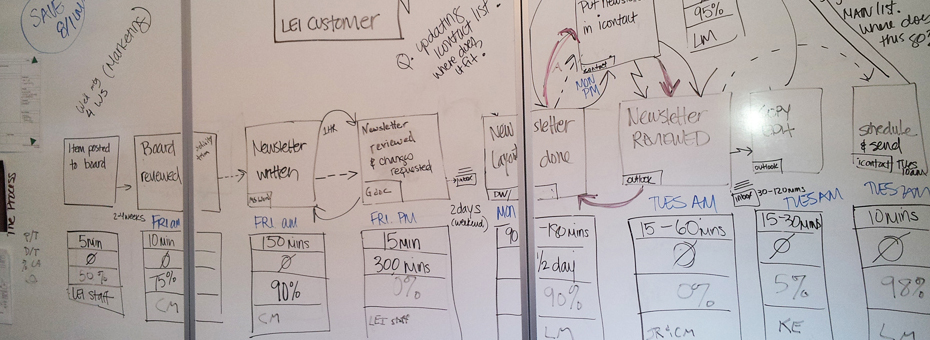Nearly 20 years after value-stream mapping was introduced to the world in the best-selling book Learning to See, countless organizations have used it successfully – not just in manufacturing, but in ‘back-office’ and service processes as well.
Value-stream mapping (VSM) is a tool that can be used to significantly redesign any system, even complex systems such as product development. When used properly it can show not just how work currently flows, but also help develop a common vision – a future state – based on the key concepts of lean which include:
- Flow
- Pull
- Leveling
- Targeted waste reduction
- How the new value stream will be managed
That’s the theory. But you might be surprised to learn that 50 percent of the maps I am asked to review are just current states with no true future states. Most often it is a current-state map with dozens of “kaizen bursts” (ideas for improvement) applied. These kaizen bursts are transferred to a list that is then prioritized by some means. Names and dates are assigned and the value stream mapping ‘event’ comes to a close with implementation occurring over the ensuing months.
This approach is akin to a ‘waste war,’ which is what too many lean efforts embody. Simply addressing the myriad waste does not necessarily improve flow, customer service and/or system performance to a significant degree. When I ask the mapping team questions such as how flow will be improved to meet market needs, or if capacity will be in line with expected future demand, the response is usually just a puzzled look. Modest projected improvements in lead time and process time are often pointed to as a reply.
So what’s missing?
What people often fail to apply to VSM are the future-state questions, which are provided in the three preeminent references on the subject: Learning to See (for manufacturing), The Complete Lean Enterprise (for office & service), and Value Stream Mapping for Lean Development (for development systems). In each book there is a set of prescriptive questions that embody lean thinking as it is applied to these three primary value streams.
The first question is some form of ‘What does the customer really need?’ It is a multipart question that defines future demand rate or rates (takt times), the lead time or service level, and the quality performance that the new system is expected to deliver. In other words, the responses to the first question (questions really) become the key design parameters upon which the future state must be designed. And certainly the future state must be aligned with the direction established by senior leadership, which should have been defined before the VSM event began. Asking and answering this question also results in a different mindset to the re-design process. Instead of a ‘war on waste’, it becomes a focused effort to determine how best to meet the objectives and ‘target conditions’ that have been clearly defined. Do not underestimate the effect that this will have on VSM team members as they move from “we’ll do as good as we can” to “here’s the ‘bar’, now let’s go meet or exceed it”.
The subsequent future state questions revolve around applying continuous flow, pull, leveling, lean management, and yes, waste, but only if it is a significant obstacle to the defined objectives. There’s no need to discuss wastes that consume a few minutes of people’s time if the objective is to reduce process time by 40 percent from a total of 20 hours. More significant ideas for change must be identified and considered. The result is usually a much shorter list of improvement efforts, each with clear expectations of how they will help meet the defined objectives. Their proper application will fundamentally change the way in which work is performed, how it flows and how it’s managed.
As opposed to waste, the importance of addressing management in VSM can’t be stressed enough. Often when we see an organization that has changed its workflow, we find that the management of the value stream was never changed. This makes sustaining the proposed changes difficult and reversion more likely, as the organization ‘learns its way to the future state.’
Remember that since the future state questions embody lean thinking, they also help VSM team members learn these concepts and gain a deeper understanding of their application. In this way, people who have participated in a VSM event will be better able to recognize their application to other processes and value streams. It’s a win-win for your organization and your people.
I ask you now to reflect on the approach that you and your organization currently take to value stream mapping. Is it more of a ‘waste war’, or is it a well-directed, thoughtful application of all of the key lean concepts with a clear future state? Are you achieving the significant results your organization needs to succeed? Are you experiencing the social benefits of the methodology? Would a different approach provide more substantial results? For more information on this important subject, check out the second edition of The Complete Lean Enterprise: Value Stream Mapping for Office and Services.





